IJCRR - 12(20), October, 2020
Pages: 52-60
Date of Publication: 27-Oct-2020
Print Article
Download XML Download PDF
Hospital Nutritional Menu Customization System Integrated with Web-based Technology
Author: Heng Chin Yee, Zety Marlia Zainal Abidin
Category: Healthcare
Abstract:Background: Hospitals aimed to serve their patients with the best medical care services and saving lives. Yet, while most attention and financial cost are spent on the medical investigation, purchasing the latest technology and machines, the food and nutrition provided to patients are having less concern. Food consumed is one of the important factors that affect patient body health recovery. Majority of the hospitalized patients are dependent on the hospital food as their nutritional resources. Problem: A nutritious, wholesome and well-balanced meal can essentially increase patient's rate of recovery without using the unnecessary nutritional supplement. However, majority hospital serves the patient with the same meal which does not suit every patient's body condition. Therefore, the patient is unable to obtain enough nutrition to support body health and recovery. This may not bring big affection to the patient who are short-term hospitalization but to those who are long term hospitalized or having serious health problems. Also, the traditional way of taking the order lead to several problems, including patient inconvenience and data lost. Objective: In this paper, a hospital nutritional menu customization system has been proposed to resolve the mentioned problems. The proposed system is designed for hospital-use to allow the patient to customize their meal based on their food preference, food portion and nutritional needs. This system aims to solve the problem of the existing manual paper-based food ordering system and increases the efficiency as well as the data accuracy.
Keywords: Health Information Management, Hospital, Food, Nutrition, BMI, Electronic Health Records
Full Text:
Introduction
Hospitals aimed to serve their patients with the best medical care services and saving lives. Yet, while most attention and financial cost are spent on the medical investigation, purchasing the latest technology and machines, the food and nutrition provided to patients are having less concern. Food consumed is one of the important factors that affect patient body health recovery.
However, the food served in the majority hospital does not meet the food quality which suitable for the patient’s recovery. To mass-produce patient meals with limited budgets, the majority hospital cuts down the budget spent on food preparation and mass-produce patient food economically. Some hospitals have abandoned the method of preparing raw food materials in-house. The patient meals are prepared through varies methods, including purchase from food catering sellers and purchase a frozen meal and partially prepared on the hospital dietary service department. This cause the unhealthiness in-hospital meal, which some of the food in their meals might even high in sugar, unhealthy fats and salt. 1,2
Besides, the food served in the hospital is compulsorily the same, but it does not suit every patient’s body condition. Therefore, the patient is unable to obtain enough nutrition to support body health and healing. This may not bring big affection to the patient who is short-term hospitalization but to those who are long term hospitalized or having serious health problems. Also, the traditional way of taking the order lead to several problems, including patient inconvenience and data lost. To solve the mentioned problems, the nutritional menu customization system is proposed. This system offers the patient with a wide variety of meal selection which matches with their health condition as well as their dietary restrictions. The proposed system aimed to satisfy the patient by providing a list of hospital meal that suits for patient’s health condition and allow customization in portion and their dietary preferences.
During hospitalization, patient meals are one of the crucial factors that lead to recovery. Majority of the hospitalized patients are dependent on the hospital food as their nutritional resources1. A nutritious, wholesome and well-balanced meal can essentially increase the patient’s rate of recovery without using unnecessary nutritional supplement2. Therefore, the hospital shall provide food that satisfies the patients and meet the nutritional requirements.
One problem of the current hospital catering service is the food wastage. One study has been carried out in the University hospitals to observe the amount of food wastage. During the 28-day-observation, more than 60% of hospital food is wasted. Total cost for the food wastage was 13,965 pounds3. The factor of causing the food wastage is mainly because the patient could not finish the food portion, lack of appetite and dissatisfied about the food quality4.
A survey is conducted in two London teaching hospitals with a total amount of 48 patients who are from 8 different acute wards to get feedback about the food quality from the patient’s perspective. According to the result of the survey, the majority of the patients are satisfied with the quality of food provided, however, the quantity served does not suit every patient. Almost half of the patients reported a problem of feeling hungry during hospitalization while a few reported could not finish the food portion5. This reflects the problem of food quantity measurement. Also, the patients complained about the difficulty of accessing food, including menus not enabling informed decision about what food met their needs and inflexible ordering systems. To solve the problem of food waste and improve the user experience of hospital food ordering system, nutritional menu customization allows patients to make the customization on their food menu. With this system, the patient can select their desire food portion, and this highly prevents food wastage. 3,4
Currently, the majority of hospitals are still using the paper system to record their patient meals. One of the biggest problems is that the patient who missed the chance to fill in the food menu before the nurse collects the paper menu will be given random meals. This action may reduce the patient’s satisfaction towards the hospital meals. Another problem with the paper system is not user friendly to the patient with special physical needs that could not fill out the paper menu by himself6. This again led to the problem of the patient cannot select meals based on their preference. Other than that, by using the paper system, the margin for error is huge. Food allergy might occur as patients forgot to fill out their orders or neglected their dietary restrictions, or the nurse forgot to inform to the dietary service department. With the nutritional menu customization system, the user can select the meal customized for them and make remarks on their dietary restrictions.7,8
To deliver a nutritional menu customization system which can generate wholesome meal that provides sufficient nutrition and satisfies patient’s preference, with the least amount of food wastage.
- To investigate the majority patient’s meal preference and desired portion
- To study food ingredient that rich of nutrients
- To research the ingredients that help in patient’s body recovery
- To store the patient’s health condition and level of nutritional needs.
-To produce a recipe after considering the patient’s body condition as well as restriction, eg: lactose intolerant, allergen
- To allow the patient to schedule their meal of the day from the generated menu
There are four user types in the HNMC system, which are patient, nutritionist, admin and food service worker. The patient can create the meal, edit meal detail, view meal detail and delete meal. Besides, the patient can add meal to a meal schedule, view meal schedule, edit meal schedule and view personal BMI. A nutritionist can register new patient, view patient information, edit patient detail and delete patient. Furthermore, the nutritionist can suggest nutritional food to the patient and view the patient’s meal schedule. Admin can register nutritionist and food service worker account, edit nutritionist and food service worker information, view all nutritionists and food service worker and delete nutritionist and food service worker account. A food service worker can view a meal delivery schedule and information.
Literature Review
Hospital meal plays an important role in the patient’s body health recovery. A healthy meal is essential for the patient that every hospital should provide to their patient. However, the current hospital menu ordering system does not satisfy the patient in various ways. Malnutrition is a common problem among hospitalized patient7. The purpose of hospital food is to provide a healthy diet to the patient during hospitalization to help them in modelling their diet behaviour. However, inappropriate hospital meal can bring a significant threat that affects the patients’ health. According to Fernando and Wijesinghe, the traditional hospital food catering system repeats the menu over weeks, therefore results in high food wastage and patient’s dissatisfaction8.
According to an article published by The Star, hospitals are unable to support the patient’s nutritional needs as the diet requirements of patients with different sicknesses are not the same. Based on this issue, the newspaper has interviewed an experienced nutritionist. The interviewee, consultant dietitian Lim Kwee Ean has introduced the legal standard of regular diet is consuming 1800-2000 kJ of energy formed by 50-55% of carbohydrates, 15-20% of proteins and less than 30% of fat. However, current hospital catering does not satisfy the patient needs and does not meet the legal standard of regular diet9. This made a great impact on the patient’s process of recovery. Improvement of hospital meal needs to be made as it is the main source for the patient to optimize their protein and energy intake during hospitalization.
One factor of causing malnutrition in hospital food is the cut down of budget in preparing hospital meal. To reduce cost, many hospitals decided to cut the budget used in the patient meal by replacing the ingredient with frozen ingredient and change the cooking method to reheating and serve ready-cooked food to the patients. In the year 2013, the Scottish Government has reduced the food and drink budgets to national hospitals from £32.6million to £29.7million. This great deduction caused the national hospitals to shut down their kitchens and began to buy in ready-made food to be served to patients10.
Another article has been published in the year 2014 regarding the cut down of catering budgets from NHS hospitals. NHS hospital has cut down the spare of cost on hospital catering, resulting thousands of NHS patient were forced to eat the reheated meal that cost less than a packet of potato chips, which makes no sense that it could be nutritious. One of the patients in the NHS hospital revealed that she was served with a bowl of boiled water with an instant soup stock cube during hospitalization11. These articles have proved that many hospitals have forgotten the needs of nutritious hospital meal to the patient and they focus on the hospital profit more than the patients. There is a need to highlight the importance of hospital meal to the hospital and raise awareness regarding the importance of nutrient levels in hospital meal. 11
Food nutrition is significant for patient’s body recovery. With good guidance on food consumed, the patient’s rate of recovery can be increased. Nutritional food is important for the patient, especially for those who need additional care. An investigation on the importance of food nutrition to patient’s recovery is being conducted in the year of 200212. A group of patients with stable angina are selected as the participant of the investigation. They are given nutritional medical food enriched with the nutrient they need during the investigation period. After a month, results showed that patients have a different level of recovery and less angina onset time after consuming the nutritional food. The nutritional meal has improved the flow-mediated vasodilation and improves their vascular function. This investigation has proven that the food provided by the hospital is significant to patient recovery.
A study on the quality of food and nutritional care in hospitals has been conducted in the year of 2012.37 hospitals are being assessed under two quality control corpora, the Nutritional Care Quality (NCQ) and the Hospital Food Service Quality (FSQ)13. However, the results of the investigation showed that both nutritional care and food services are all below standard14. Due to the financial control and the allocation of budgets, majority hospitals did not pay concern to the nutrition level of hospital meal, and not aware of the importance of providing highly nutritious food to the patients15. A survey is conducted by the Campaign for Better Hospital Food Organization to investigate the quality of hospital meal in London hospitals. The result shows that among all London hospitals, only 23% provide freshly prepared meals to the patients and 77% serves reheated airline-style food from plastic containers to their patients. More than half of the investigated hospital has failed to meet the basic standards for hydration and nutrition as the quality of the meal served to the patient are worse than those served in prisons and schools16. This investigation has shown that currently, the majority hospital does not serve fresh and tasty food to the patient.
Research Towards Nutrition Information
The proposed system aims to achieve in assisting the patient to customize a healthy and nutritional meal that fulfil nutritional needs for body recovery and satisfy the patient’s dietary preference. The food consumed by the patient is important and needs to be measured. A dietary concept is proposed by the United State Department of Agriculture under one of the Nutrition Policy and Promotion of US (CNPP). The concept of MyPlate is to build healthy eating habits in our daily life and to improve the nutrition consumptions of Americans17.
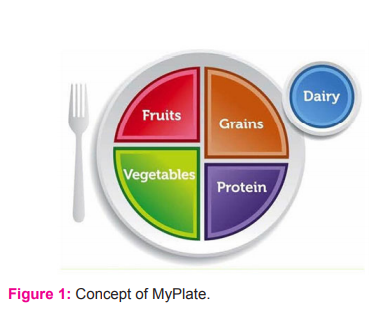
Figure 1 illustrates the concept of MyPlate. The image of MyPlate is a plate that divided into four sections with a circle component on the right of the plate. The image allows the user to visualize the nutrients and amount of each nutrient he or she should consume. The MyPlate shown in the diagram refers to the nutrient consumptions of a person without health issues, therefore, the portion and the needs of consuming each nutrient are varying depends on an individual’s health conditions. In the HNMC system, the concept of MyPlate is adopted. Each patient’s MyPlate is being customized based on their dietary restrictions and the health condition.
Other than the portion of nutrient consumption, ingredients that made up a meal needs to be concerned. The food pyramid is designed by grouping the food and ingredients according to their nutrient’s similarity. By referring to the food pyramid, people can know if they are consuming the right amount of the basic nutrients and the food to boost each nutrient. However, the normal food pyramid is only suitable for people who are healthy that has no health issues. The needs for healthy people in the diet is to maintain their body healthy and sustain their body energy. This is not suitable to be adopted by a person with a health issue as their main concern is to improve their health condition and recovery.
Based on the concern, a food pyramid for the patient has been proposed by the University of Michigan Health System18. It is known as healing foods pyramid and it was built upon the needs of the patient. It emphasizes foods that nourish the body and contains healing qualities and essential nutrients that able to sustain energy over time. Apart from the normal food pyramids, it focuses on the nutrients that able to supply body energy and vitamins to boost the body recovery18.
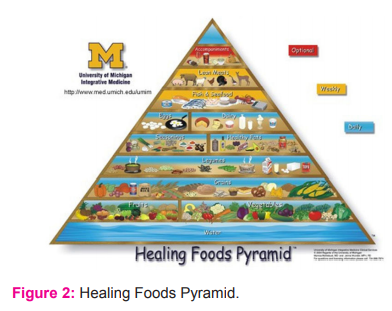
In the healing foods pyramid, the bottom of the pyramid contains water, Figure 2. Water is important as the body needs water in all the cells, tissues and organs to maintain bodily functions. It is a need for the patient to consume a larger amount of water in sustaining body condition and stay hydrated. Vegetables and fruits are in the second last of the pyramid. They are the main source of vitamins and minerals. They contain high fibre that helps to maintain the health of the gut and prevent constipation and digestion problems19.
By referring to the healing foods pyramid, the nutritional food provided in the system is being selected and filtered. All fruits and vegetables contain healthful fibre, minerals and vitamins. However, some has better health benefits compared to others.20 In the system, it stores the fruits and vegetables that provide most healthful nutrients that can help in the patient’s body recovery.
Similar System
Nowadays, there are a few hospital food catering system on the market. Below is Table 1 of the competitor of a nutritional menu customization system.
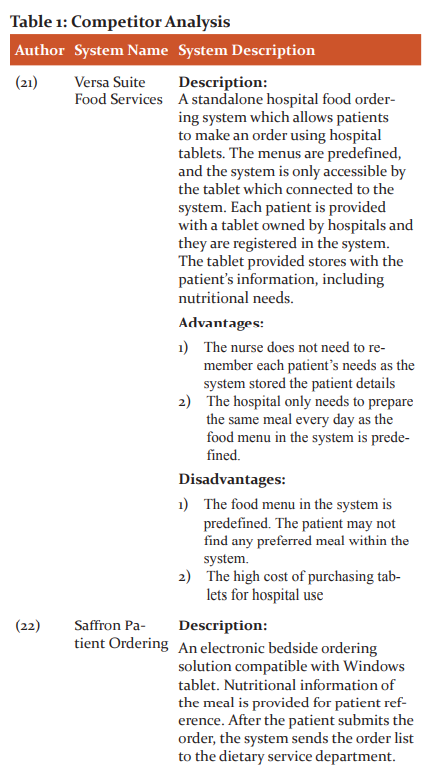

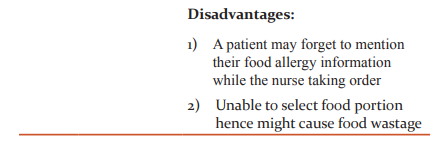
The nutritional menu customization system is a comprehensive patient meal service system that focuses on patient’s dietary preference as well as their health condition. It customizes and suggests food menu for the patient based on their body health condition. It takes patients food preference, dietary restrictions and allergy ingredients into consideration and aims to generate the most suitable menu to the patient.
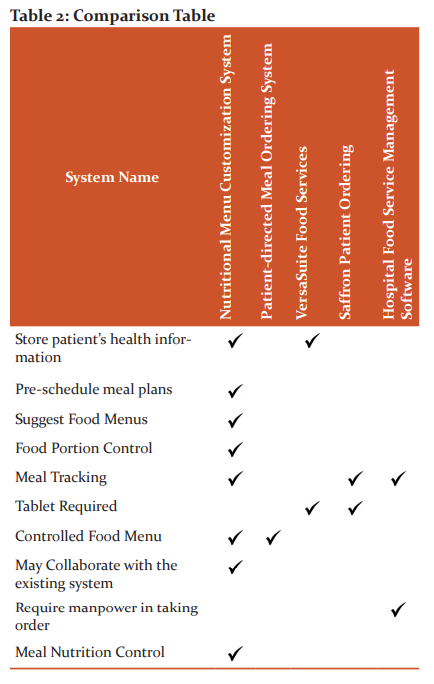
Based on the comparison Table 2 provided, nutritional menu customization system is equipped with majority features. It is a system that allows the nutritionist to customize food menu for each patient according to their health condition to fulfil the patient’s nutritional needs. It first collects the information about the patient, including the patient’s allergens, body health condition and what nutrition the patient lack of. With the information, system checks for the nutritional food that is suitable for the patient. After that, it generates a list of healthy food which suits the patient. To satisfy the patient’s preference, he or she can view and select the food from the list of generated menus as the meal of the day. Also, to prevent food wastage, the patient can choose the food portion that he or she can finish.
Technical Research
C# is being selected as the programming language for the Hospital Nutritional Menu customization system development. Visual Studio 2017 is selected as the IDE and entity framework is selected as the libraries and tools of the proposed system. Microsoft SQL Server is chosen as the database management system and Windows 10 is being selected as the operating system of the proposed system. Internet Information Services (IIS) is selected as the webserver and google chrome is selected as the web browser of the proposed system. Static Content Hosting is adopted as the cloud design pattern for the HNMC system development.
System Development methodology refers to the framework used in structuring, planning and controlling a system development process24. Various methodologies are being identified. Among all, three methodologies are being introduced and compared in Table 3 to select the most appropriate methodology to be used in the HNMC system development.
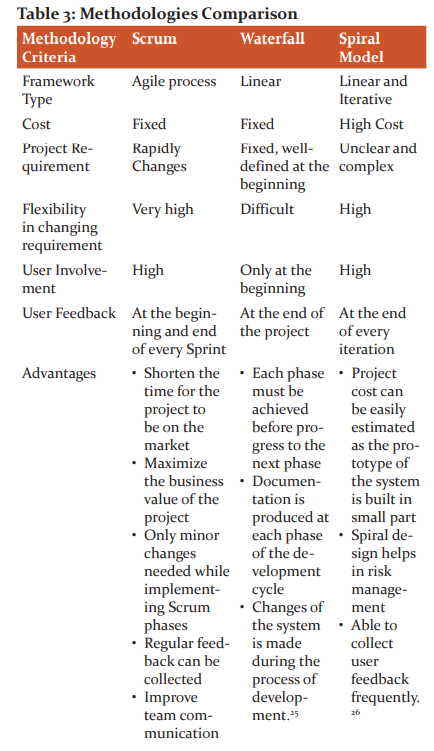

Through comparison, Scrum methodology is being selected. Scrum methodology is the most preferred methodology for HNMC system development. It is an agile project management methodology that able to deliver a higher-quality system in a short period. Also, its iterative nature allows the system to adapt to the changes made during the development phase. It has high adaptability to change as it prevents changes from disrupting the entire project course. Scrum made the development process high in transparency as the developers can ensure what is being developed is what they are expecting. By using Scrum methodology, the developer can have a clear big picture on the project estimated time, resource and cost27.
Implementation
In this page, the admin needs to insert patient’s basic information, including patient full name, Date of Birth, gender, BayID, Duration of hospitalization and religion. Admin can select patient hospitalization starting date and ending date using the calendar, Figure 3.

In this page, the admin needs to insert food name, select food category and select food availability in restriction. Admin can select food category from the dropdown list and click on the food restriction checkbox to select the food availability in the restriction, Figure 4.
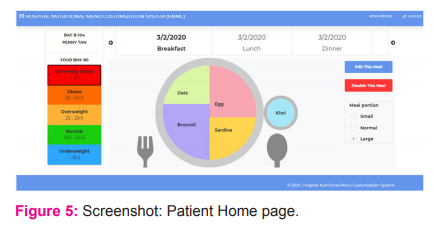
In the patient home page, patient Bay ID and the patient name is displayed on the left of the page. Patient BMI is displayed and a BMI range and categories are shown below the patient name (shown in Figure 5). Patient’s BMI level is highlighted with a black border around the level to indicate the patient. The patient BMI is calculated based on the weight and height inserted by the nutritionist and the patient is only allowed to view the BMI but not edit it. The patient meal schedule is displayed on the right side of the BMI range. In the patient meal schedule, it shows the patient meal schedule along with the patient meal and the portion. In the meal schedule, a carousel is used to allow the patient to change and select the meal schedule. The patient can click the left arrow to view previous meal schedule and right arrow to view the next meal schedule. Table 4 and Table 5 presents the unit test for the login and add a meal.
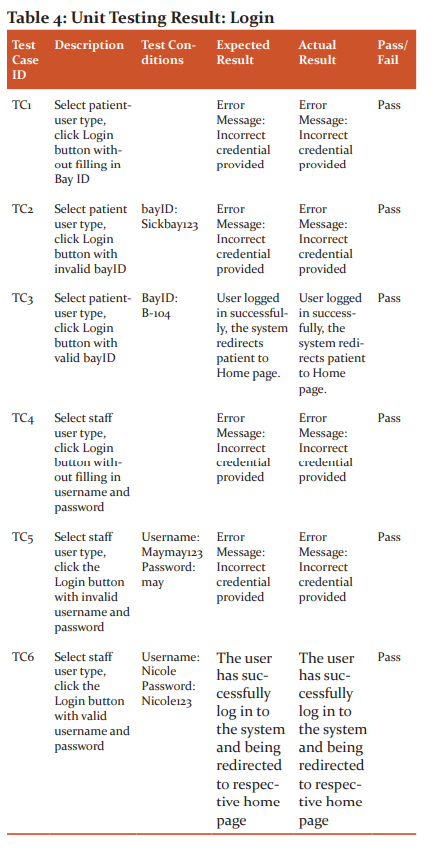

There are several features that the Hospital Nutritional Menu Customization system does not involve, which is being defined as the limitation of the system. In the HNMC system, nutritionist is in charge of select nutrition food ingredients to a patient. A nutritionist can select up to 5 foods in each nutrition group to a patient, which is 25 food options in total. However, the patient might not be satisfying with the food ingredients suggested by the nutritionist. If the patient does not satisfy with all 5 food ingredients suggested by a nutritionist, he or she can only inform the nutritionist through communication externally outside of the system as the system does not provide a platform for the user to interact with each other.
The second limitation is the food portion estimation. The patient can select the portion of food in a small, normal and large portion. However, there is no exact measure or ways to define the serving size of the food as the term ‘normal’ is ambiguous. The patient cannot visualize the serving size of the food portion until the meal is served to him or her. Hence, despite the system allows the patient to select the meal portion and the options are provided, the patient might still have confusion on deciding the food portion.
In the HNMC system, some enhancement can be achieved in future time, which is shown as below:
-Private Chat between user and nutritionist
Currently, the system does not support interaction between patient and nutritionist. Thus, if the patient has any question or inquiries towards his nutritional information, the patient can only consult the nutritionist outside of the system. In future enhancement, a chat function can be implemented to allow the patient to consult the nutritionist using the system.
- Allow Upload Image File
Currently, the system provides nutritional food without showing the image. Also, the patient might have difficulty in visualizing the food portion. In future time, enhancement can be made to allow the admin to upload image file on the portion serving size and the image of nutritional food.
Conclusion
Throughout the software development, the proposed Hospital Nutritional Menu Customization system is being developed. The system involves four user types, which are admin, nutritionist, patient and food, service worker. By using the system, admin can manage user accounts and nutritional foods in the system. A nutritionist can add nutrition information for patients and suggest nutritional foods for the patient. With the system, the patient can customize the meal schedule with their desirable food portion and foods. Foodservice worker can view the meal delivery information to know the time and sickbay to deliver the meal.
To achieve the project aim and objectives, the developer spent a considerable amount of time in investigating and conducting research towards the problem and solution. After studied through journals and articles related to hospital catering services, the developer collected sufficient information towards the current situation of the majority food catering system in hospitals. The developer conducted a study on the methods of resolving the realized problem and finally, the developer adopted the concept of MyPlate and healing food pyramid as the guide of patient nutrition consumption. In the system design, the developer designed the storyboard of the proposed system. The main feature of the system is to allow the patient to customize their meal. Thus, the developer spent some time designing the metal plate based on the MyPlate concept. During the development of the HNMC system, the developer created a functional meal plate using the design illustrated in storyboard and majority webpages are designed according to the storyboard of the system.
For future enhancement, the developer would like to improve on the system by adding more remarks to indicate the user what to do on each page. Also, the developer would like to develop on a chat platform within the HNMC system to allow the patient to interact with the nutritionist. Other than that, the developer would like to enable admin and nutritionist in adding remarks for the patient that has special needs in future time.
Acknowledgements
The authors also wish to express gratitude to the management of Asia Pacific University of Technology & Innovation (APU) for their support.
Conflict of Interest
The authors involved in the current study does not declare any competing conflict of interest.
Funding and Sponsorship
No fund or sponsorship in any form was obtained from any organization for carrying out this research work.
References:
1. Hartwell H, Edwards JS. A preliminary assessment of two hospital food service systems using parameters of food safety and consumer opinion. The journal of the Royal Society for the Promotion of Health. 2001 Dec;121(4):236-42.
2. Cymru, Swyddfa Archwilio.Hospital Catering and Patient Nutrition. United Kingdom: Wales Audit Office, 2011.
3. Naithani S, Whelan K, Thomas J, Gulliford MC, Morgan M. Hospital inpatients’ experiences of access to food: a qualitative interview and observational study. Health Expectations. 2008 Sep;11(3):294-303.
4. Sahin B, Demir C, Celik Y, Teke AK. Factors affecting satisfaction level with the food services in a military hospital. Journal of medical systems. 2006 Oct 1;30(5):381-7.
5. Watters CA, Sorensen J, Fiala A, Wismer W. Exploring patient satisfaction with foodservice through focus groups and meal rounds. Journal of the American dietetic association. 2003 Oct 1;103(10):1347-9.
6. Breitmeyer, Richard. Limitation of Manual Data Entry In Hospital Catering System. [Online] 2015. [Cited: December 24, 2018.] https://klipboard.io/limitation-of-manual-data-entry-in-hospital-catering-system/.
7. Azeman AR, Adenan H. Patients Satisifaction Towards Private Hospital Food Services in Melaka. Journal of Hospitality and Networks. 2018;1(1):32-6.
8. Fernando GH, Wijesinghe CJ. Quality and standards of hospital food service; a critical analysis and suggestions for improvements. Galle Medical Journal. 2017 Dec 11;22(2).
9. The Star Online. The art of hospital food. [Online] 2004. [Cited: October 05, 2019.] https://www.thestar.com.my/lifestyle/health/2004/01/04/the-art-of-hospital-food.
10. Daily Mail. Revealed: The 89p meals that shame NHS hospitals after catering budgets slashed by up to 10%. [Online] 2014. [Cited: October 05, 2019.] https://www.dailymail.co.uk/news/article-2804476/Meals-shame-Scottish-hospitals-3million-cuts-hit-hospital-food-forcing-thousands-patients-eat-89p-dishes.html.
11. Matthews, Stephen. Government launches review into food served in NHS hospitals in the wake of listeria deaths linked to pre-packaged sandwiches - and Great British Bake Off’s Prue Leith will act as an advisor. [Online] 2019. [Cited: October 05, 2019.] https://www.dailymail.co.uk/health/article-7383527/Government-launches-review-food-served-NHS-hospitals.html.
12. Maxwell AJ, Zapien MP, Pearce GL, MacCallum G, Stone PH. Randomized trial of a medical food for the dietary management of chronic, stable angina. Journal of the American College of Cardiology. 2002 Jan 2;39(1):37-45.
13. Donini LM, Castellaneta E, De Guglielmi S, De Felice MR, Savina C, Coletti C, Paolini M, Cannella C. Improvement in the quality of the catering service of a rehabilitation hospital. Clinical Nutrition. 2008 Feb 1;27(1):105-14.
14. Diez-Garcia RW, de Sousa AA, da Costa Proença RP, Leandro-Merhi VA, Martinez EZ. Gauging food and nutritional care quality in hospitals. Nutrition Journal. 2012 Dec 1;11(1):66.
15. Beck AM, Balkn UN, Fürst P, Hasunen K, Jones L, Keller U, Melchior JC, Mikkelsen BE, Schauder P, Sivonen L, Zinck O. Food and nutritional care in hospitals: how to prevent undernutrition–report and guidelines from the Council of Europe. Clinical Nutrition. 2001 Oct 1;20(5):455-60.
16. Knapton, Sarah. Hospital food divide: doctors and nurses eat better than sick patients. [Online] 2017. [Cited: October 05, 2019.] https://www.telegraph.co.uk/science/2017/03/23/hospital-food-divide-doctors-nurses-eat-better-sick-patients/.
17. USDA. ChooseMyPlate. [Online] 2020. [Cited: January 14, 2020.] https://www.choosemyplate.gov/.
18. Riley M, Locke A, Skye EP. Health maintenance in school-aged children: Part II. Counseling recommendations. American family physician. 2011 Mar 15;83(6):689-94.
19. NHS. WHY 5 A DAY? [Online] 2020. [Cited: January 15, 2020.] https://www.nhs.uk/live-well/eat-well/why-5-a-day/.
20. Marengo, Katherine. What are the most healthful vegetables? [Online] 2018. [Cited: January 16, 2020.] https://www.medicalnewstoday.com/articles/323319.
21. VersaSuite. The Food Services Solution for Facilities of All Sizes. [Online] 2019. [Cited: January 02, 2019.] https://versasuite.com/food-services/.
22. Saffron. Saffron Patient Ordering. [Online] 2019. [Cited: January 02, 2019.] https://fdhospitality.com/product/saffron-patient-ordering/.
23. RMS Omega HealthCare Technologies. Software Hospital Food Service Management: Manage Food Service Operations within the Hospital. [Online] 2019. [Cited: January 02, 2019.] https://rmsomega.com/healthcare/products/food-service-management/.
24. Bagaro, Lodza. Systems development methodology. [Online] 2016. [Cited: October 04, 2019.] https://www.supinfo.com/articles/single/2880-systems-development-methodology.
25. TutorialsPoint. SDLC - Waterfall Model. [Online] 2019. [Cited: October 06, 2019.] https://www.tutorialspoint.com/sdlc/sdlc_waterfall_model.htm.
26. —. SDLC - Spiral Model. [Online] 2019. [Cited: October 05, 2019.] https://www.tutorialspoint.com/sdlc/sdlc_spiral_model.htm.
27. Guru99. Agile Vs Scrum: Know the Difference. [Online] 2019. [Cited: October 05, 2019.] https://www.guru99.com/agile-vs-scrum.html
|






 This work is licensed under a Creative Commons Attribution-NonCommercial 4.0 International License
This work is licensed under a Creative Commons Attribution-NonCommercial 4.0 International License